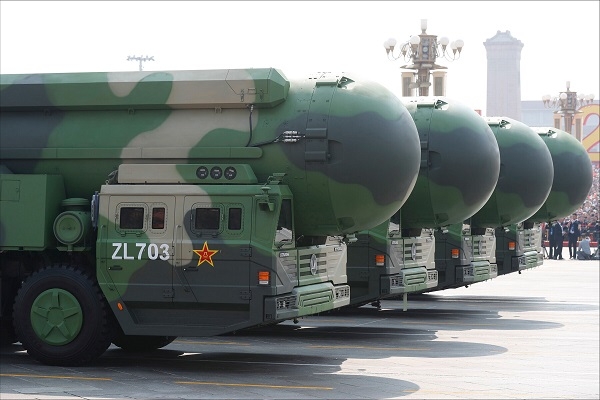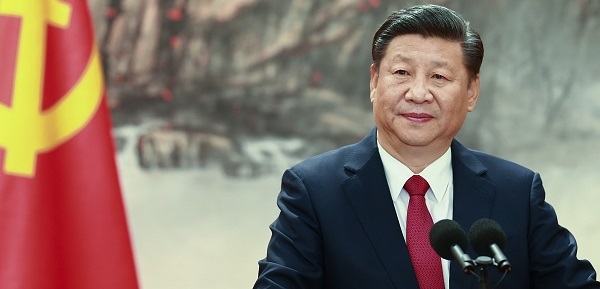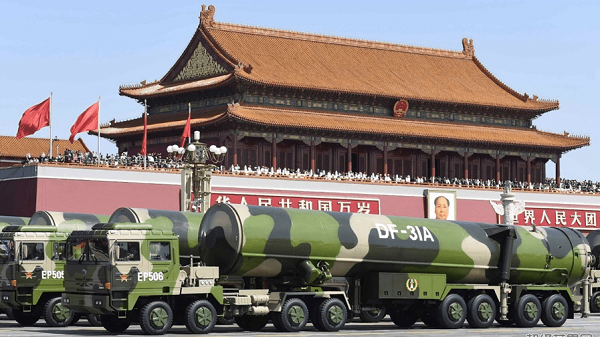China’s Nuclear War fighting Policies: TRIAD Force Levels and Capabilities
31 Jul 2020 11:01:31
As an afterthought, an attempt has been made to review in broad outline China “Nuclear Policies, its TRIAD Force Levels and capabilities to deter nuclear wars.
Policy Trends
China is not a member of nuclear arms control mechanisms. Xi Jinping can ill afford to consider entering into an INF-like treaty and eliminating 95% of China’s entire ballistic and cruise missile inventory, particularly in the face of deteriorating relations with the USA as on date. Consequently, the risk of a great-power nuclear arms race is growing by the day.
Ambiguity of China’s policy is real. Chinese Defence White Papers 2008, 2010, 2013 and 2015 provides insights into nuclear forces and strategy and its evolutionary trends. Despite omission of No-First-Use (NFU) policy in the 2013 Paper, its avowed policy remains NFU. “Limited Deterrence” – shift from minimum deterrence – is its declared military nuclear strategy. Under "limited deterrence" doctrine, China would need to target nuclear forces in addition to cities, which would require expanded deployments.

The 2015 Paper reiterates that “the nuclear force is a strategic cornerstone for safeguarding national sovereignty and security. China will unconditionally not use or threaten to use nuclear weapons against non-nuclear-weapon states or in nuclear-weapon-free zones, and will never enter into a nuclear arms race with any other country. China has always kept its nuclear capabilities at the minimum level required for maintaining its national security. China will optimize its nuclear force structure, improve strategic early warning, command and control, missile penetration, rapid reaction, and survivability and protection, and deter other countries from using or threatening to use nuclear weapons against China.” All high on moral rhetoric!
Chinese primary goal is deterring nuclear attack and coercion - termed as defensive nuclear deterrence focused on assured retaliation. The objective of Chinese retaliatory nuclear attack is to cause the enemy to cease future nuclear attacks against China. China is steadily improving strategic nuclear delivery capabilities and ability to use nuclear weapons on a theatre basis. It is persisting with modernizing catering to emerging threat perceptions: besides the USA, North Korea, Russia, India and Pakistan have nuclear weapons; and, the ROK or Japan may also develop nuclear weapons in future. China is also concerned about the deployment of theatre missile defence systems in Japan and South Korea.
China’s nuclear weapons policy, therefore, prioritizes maintaining a nuclear force able to survive an attack and to respond with sufficient strength to inflict unacceptable damage on an enemy. As per experts, the shift in Chinese strategy is discernible with the process of a major modernization of its nuclear-armed missile forces and development of a “stealth” strike aircraft – the J-20 and J-31. It is also adopting multiple independently targetable re-entry vehicle (MIRV) warheads for its strategic missiles – shift from a single warhead on a single missile. The MIRVs and penetration aids are intended to ensure the viability of China’s strategic deterrent. China seems to have bypassed intermediate improvements like multiple re-entry vehicle (MRV) missiles that carry several warheads which are dispersed but are all aimed at the same target or manoeuvrable re-entry vehicle (MaRV) missiles, which allows warhead movement to be adjusted midflight. The PLA has deployed new command, control, and communications capabilities to its nuclear forces to improve control of multiple units in the field.
One of the objectives of the ongoing series of Chinese nuclear tests is to miniaturize nuclear warheads, dropping their weight from 2200 kgs to 700 kgs in order to accommodate the next generation of solid-fuelled missile systems. Chinese cruise missiles can be armed with nuclear payloads but U.S. assessments state they are not.
Since 2014, China has carried out several tests of its hypersonic glide vehicle (HGV). The HGV, the DF-ZF, is launched during the last stage of a missile and can reach nearly 7,500 mph (Mach 10), as well as maneuver to avoid missile defenses and zero-in on targets. This weapon can be configured to carry a nuclear or conventional warhead and China claims it is precise enough to attack ships at sea. Hypersonic weapons could also compress the amount of time leaders have to make decisions in times of crisis, because they can strike much faster than other weapons.
China primarily caters to the USA threat contingency. The USA has over 1,600 deployed strategic warheads and 150 non-strategic warheads as of 2019. The USA has an estimated 3,800 warheads stockpiled. In addition to these warheads, approximately 2,385 retired bringing the total U.S. inventory of stockpiled/retired to roughly 6,185 warheads.
China’s Nuclear Warheads Estimates
First, the number of nuclear warheads in China's arsenal is a “Top State Secret”. There are varying estimates available ranging from 200 to 3000. Whatever data is available in public domain dates back to 2015. As per estimates by the Federation of American Scientists, China is said o have an arsenal of about 260 total warheads.
The Chinese are estimated to have only 2 tons of weapons-grade plutonium, which limits their arsenal to 450–600 weapons, despite an 18-ton disposable supply of uranium, theoretically enough for 1,000 warheads. As per experts, to produce 3,000 nuclear weapons, China would require 9–12 tons of plutonium, 45–75 tons of enriched uranium and substantial amount of tritium.

Based on Russian expert claims, China’s HEU stockpile is actually 40 tons, and a plutonium inventory of up to 10 tons. So, China could have 1,600 to 1,800 warheads. As per other experts using estimate of 4-8 kilograms of plutonium per warhead, they conclude a total force of probably no more than 375 warheads, with an extreme upper bound of no more than 700 warheads.
As per assessments, China has at least six different types of nuclear payload assemblies: a 15-40 kiloton (kt) fission bomb; a 20 kt missile warhead; a 3 megaton (mt) thermonuclear missile warhead; a 3 mt thermonuclear gravity bomb; a 4-5 mt missile warhead; and a 200-300 kt missile warhead.
As per yet another recent report, while India had 130-140 nuclear warheads in 2019, it has 150 in 2020; Pakistan had 150-160 last year, and now has 160; and China had 290 such warheads in 2019, now is has 320. None can rule out China having "more than double" - nearly 600 warheads.
Missiles Inventory
China’s missiles inventory by various categories is as given below:
• Inter Continental Ballistic Missiles (ICBM)s: 75-100 ICBMs – two types: silo- based CSS-3/DF-4 range 5,500 + kms; CSS-4 /DF-5 range 12,000 to 13,000 kms; CSS-4 Mod 2/DF-5A and MIRV-equipped; and Road-mobile CSS-10 Mod 1/DF-31 and CSS-10 Mod 2/ DF-31A with range of more than 11,200 kms; and developing a new MIRV-capable road-mobile ICBM, the CSS-X-10/DF-41 range 12,000-15,000 kms.
• Hypersonic Glide Vehicle (HGVs): DF-17 range 1,800-2,500 kms;
• Ground Launched Cruise Missiles (GLCMs): Around 570 – HN 1 range 50-650 kms; HN 2 range 1,400-1,800 kms, HN 3 range 3,000 kms; YJ-18 range 220-540 kms.
• Intermediate Range Ballistic Missile (IRBM) – 150 to 160 IRBMs - DF-26 capable of conducting precision strikes against ground targets with range of 4000 kms.
• Medium Range Ballistic Missiles (MRBM) - 250-260 MRBMs -CSS-5/DF-21D range 1500-1,750+ kms; CSS-5 Mod-5/DF-21D range 1,500 + kms; and advanced DF-16 displayed in 2017;
• Short Range Ballistic Missiles (SRBMs) – 450-700 SRBMs - CSS-6/DF-15 range 300-600 kms; CSS-7/DF-11 range 600-850+; CSS-11/DF-16 ballistic missile, range 800 to 1,000 kms; DF-12 range 420 kms; DF-15 range 600 kms;
Triad Delivery Means Capabilities - PLARF (Former Second Artillery Force - PLASAF)
On the “Triad” delivery means front, China has made impressive progress. Basic facts include:
• Land Based Missiles (PLARF): The PLARF is the core force for China's strategic deterrence - comprehensive missile force. But, most of the missile force is made up of non-nuclear short-range missiles. PLARF is significantly smaller than the nuclear missile arsenal of either Russia or the United States. Recently, China is also enhancing its capabilities of strategic deterrence; nuclear counterattack and conventional precision strike are being steadily elevated. Some key developments of delivery means are given below:
- ICBM Dongfeng-41 (DF-41, CSS-X-10): one of the deadliest three-stage self propellant missile. Range estimated between 12,000 km and 15,000 km. Maximum payload capacity of 2,500kg and can carry up to 12 MIRVs (multiple independently targetable re-entry vehicles) and augmented with decoys and jammers to confuse enemy sensors, letting the actual warheads slip past missile defences. Chinese Rocket Force brigade of 10-12 launchers. Employs an inertial navigation system with updates from the BeiDou navigation satellite system. Road-mobile offers improved survivability.
- DongFeng 5A (DF-5A): Range of 13,000 kms - capable of reaching targets within the USA. Maximum payload from 3,000kg to 3,200kg. Can carry 5 megaton "city buster" hydrogen bomb, or, 3 to 8 MIRV nuclear warheads.
- DongFeng 31 A (DF-31A:) Range of 11,200 kms - carries a single thermal nuclear warhead of 1,000kt. Launched from silos or transported on a transporter-erector-launcher (TEL) vehicle.
• Submarine-launched Ballistic Missiles (SSBN) - PLAN: JIN-class nuclear-powered ballistic missile submarine (SSBN), with four commissioned and another under construction. The JL-2 submarine-launched ballistic missile (SLBM), modified version of DF-31, underwent successful testing in 2012 which has nearly three times the range of the Xia SSBN’s JL-1 SLBM. The Jin/JL-2 weapon system will provide China with a capability to strike targets in the USA from some patrol areas. The Jin SSBNs, estimated range of 7400 km, are designed to carry the 12 new JL-2 (CSS-NX-14) equipped with a single warhead:
- Type 094A: 6,213-mile range JL-2A missiles. Can attack parts of the continental USA from Chinese home waters, but not stealthy.
- Type 096 SSBN: Stealthier than the Type 094A. Range of 7,200 km. New missile – JL-3 - to replace the JL-2.
• Air Launched Cruise Missiles (ALCM) - PLAAF:
- H-6K Bomber: Capable of CJ-20 cruise missile. Combined combat radius of the H-6K (2,175 miles) and CJ-20
range (1,243 miles) are too short to reach continental US territory. Carry 7 KD-20s,
- H-6M Bomber: Can carry two DH-10 cruise missiles.
- H-X Stealth Bomber: Probably carry at least a dozen cruise missiles.
China has developed extensive network of underground facilities (UGFs) to conceal and protect critical ballistic and cruise missiles and other systems designed for anti-access/area denial weapons and also stockpile of nuclear weapons - over 5,000 km network. UGFs conceal and increase the survivability of weapons of mass destruction, strategic command and control, leadership protection and relocation, research and development, production and strategic military assets.
China is concerned with advances in ballistic missile defence (BMD) that may threaten assured retaliation and uncertainty. China is said to be working on a range of technologies to counter U.S. and other countries’ BMD systems, including manoeuvrable re-entry vehicles (MaRV), MIRVs, decoys, chaff, jamming, and thermal shielding.
China’s experts are fully aware of the acute limits on the ability of any theatre missile defence system to intercept a strategic nuclear missile because of its location, vector, and apogee and re-entry velocity. It is also aware of the fact that U.S. satellite systems can warn of the launch and vector of Chinese strategic missiles, and actual battle management of a strategic missile defence system will rely on radars nearer to, or in U.S. territory. Thus, modernization of China’s missile force has been progressing significantly during the recent past. The modernized force is more mobile, responsive, and accurate, and can overwhelm a limited U.S. ballistic missile defence system.
Of China’s 75-100 ICBMs, an estimated 40–50 can target the continental USA. With the addition of multiple warheads on the DF-5B and the DF-41 in the future, the number of ICBM warheads primarily targeted against the United States may exceed 100.

Overview
In sum, the evolution of China’s nuclear weapon systems in the past had occurred more slowly and on a smaller scale than that of the USA and the Soviet Union/Russia. According to nuclear war analysts, Chinese capabilities are nowhere near the level required by the concept of limited deterrence. China’s main concern is making sure that its minimum nuclear deterrent would survive a first strike, and for that reason it spends considerable resources on modernizing and hiding its land-based missiles - equipping its silo-based missiles with the capability to carry multiple warheads. It’s modernization efforts are today focused on developing solid-fuelled missiles that can be deployed on mobile platforms, to reduce the likelihood its missiles could be destroyed in a first strike, compared to its original liquid- fuelled missiles at fixed launch sites.
China is slow to deploy nuclear weapons at sea, where submarines can be sunk by unfriendly forces. Should China eventually begin to deploy submarine-launched missiles, deployment would require placing both the warheads and missiles on the submarine, giving the commander greater responsibility and independence under conditions in which continuous secure and reliable communications with the political leadership are more difficult to maintain. This could be seen as weakening the Chinese leadership’s tight control over its command and control.
Considering China’s nuclear force levels and constraints today, a nuclear war is ruled out in short term context.
